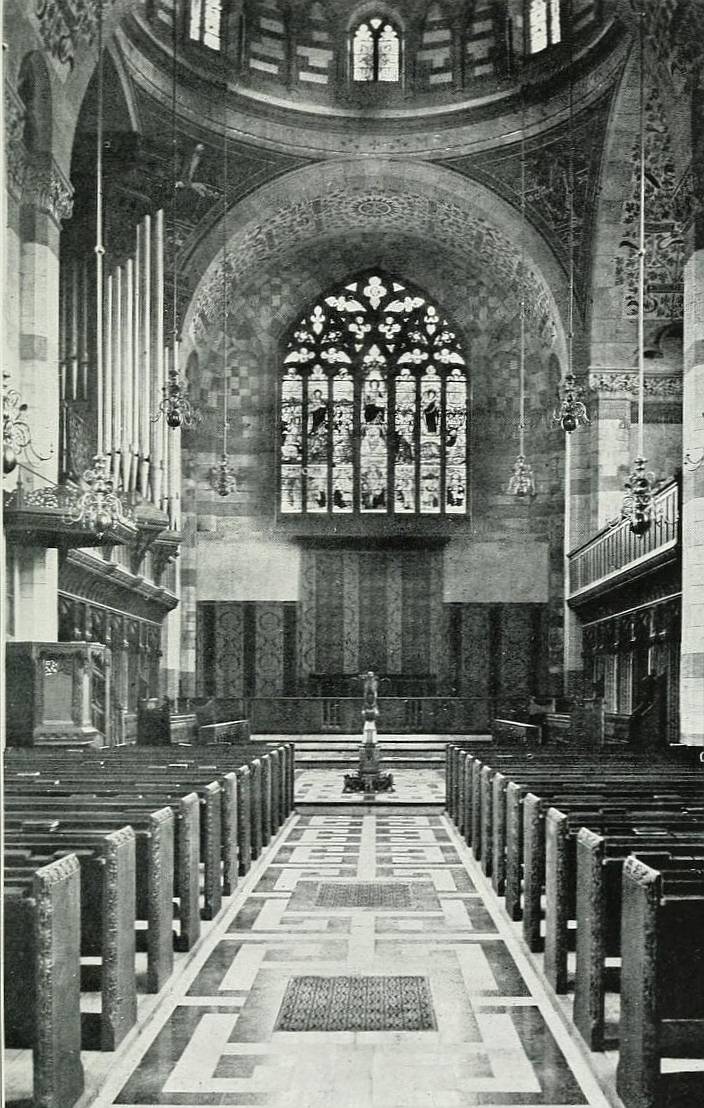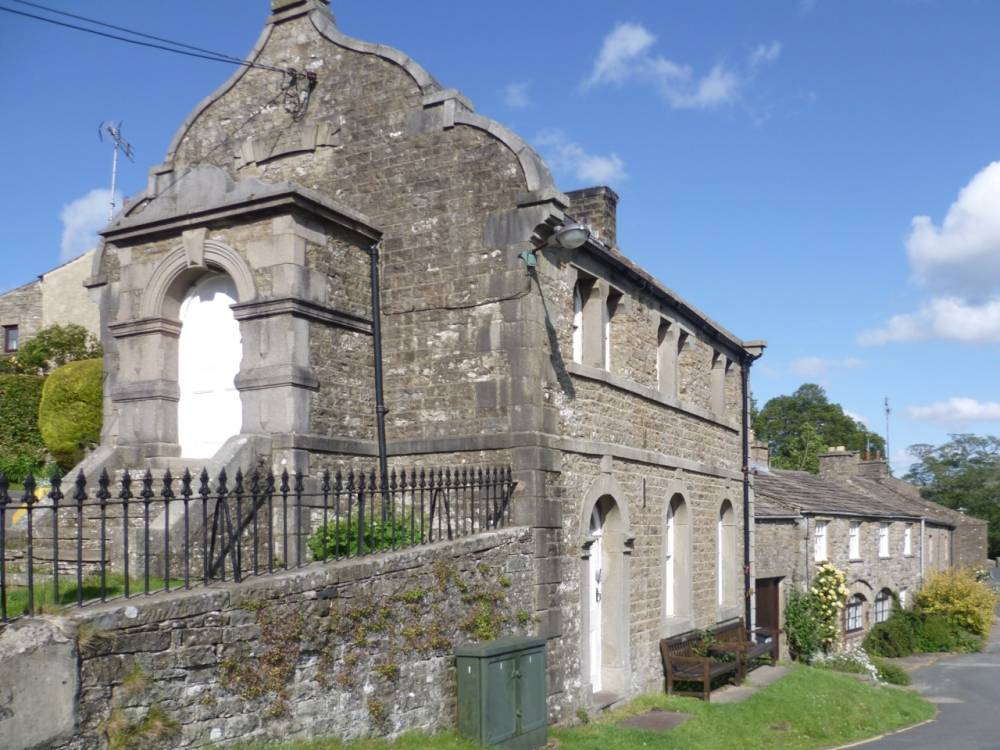All photographs are by the present author. You may use them without prior permission for any scholarly or educational purpose as long as you (1) credit the photographer and (2) link your document to this URL in a web document or cite the Victorian Web in a print one. Click on all images, even the bigger ones, to enlarge them.
Education
Yorkshire schools have had an awful press in Victorian fiction: consider Dotheboys Hall in Nicholas Nickleby and Lowood in Jane Eyre. As for the former, there had been a long established network of cheap Yorkshire boarding schools since the mid-eighteenth century, and Dickens himself went to see some of them on a "swift fact-finding mission" (Slater 9), basing the cruel establishment run by Mr Squeers on schools like the Bowes Academy near Greta Bridge, which advertised the fact that it gave no holidays. This does not appear to have been a special case, certainly not the worst: "the keeping of these 'Academies' was quite a flourishing trade in certain parts of Yorkshire, and the young Author was fighting vested interests of some power and importance" (Cumberland 13).



Three illustrations from Dickens's Nicholas Nickleby of Dotheboys Hall. Left to right: (a) "Wackford Squeers and the New Pupil," by Harold Copping, 1924. (b) The Internal Economy of Dotheboys Hall and (c) Nicholas Astonishes Mr. Squeers and Family, both by Phiz (Hablot K. Browne).
Jane Eyre's harsh experiences were similarly based on fact — the original premises of Cowan Bridge Clergy Daughters' School, where Charlotte Brontë herself suffered, can still be seen close to the little market town of Kirby Lonsdale (see Scholes 45). But there were some fine schools too, and some good educational initiatives during the period.

Dent National School, 1845.
This little school with the rather grand name was one of those founded by the National Society for Promoting Religious Education. Headquartered in London, the society aimed to provided basic schooling, as well as religious education, for the children of the poor in every parish. A similar school had been opened just the year before in Haworth, where the Brontë family lived on the Yorkshire Moors. There, we know, "[a]t a nominal charge of twopence per week, irrespective of age or proficiency, the pupils were taught everything from the three "Rs' to singing, and had their books, slates and pencils provided free of charge" (Barker 430). But funds were scarce at such schools, so, although the National Society undertook to train a certain number of teachers, they employed the monitorial system developed by Andrew Bell for use in India, which entailed assigning pupils from the highest class to pass on their lessons to those beneath them (see Meiklejohn 26). This had obvious disadvantages: "they used to put boys over me that could na read better than meesel [sic]," recalled one of those who studied under such a system (qtd. in Gardner 29). That being said, the one in Dent seems to have been particularly successful, since an extension was opened in 1897 to mark the Queen's Diamond Jubilee.

Hawes Community Primary School (originally Hawes County Primary School), 1879.
When William Forster's Education Act of 1870 divided the whole country into school districts with school boards, schools like this one in Hawes sprang up everywhere. With its commanding position at the top of the hill in the busy market town, Hawes County Primary School, as it was then known, announced the arrival of a whole new era in the history of education. It was not yet compulsory, even up to the age of ten — that would come the following year, 1880. And it was not yet free: pupils at such schools had to make contributions to their education. Elementary education would become completely free only in 1891. See entries under these years in Victorian Legislation: A Timeline. But the groundwork for both these advances was now laid.


Right: Sedbergh School, now the school library building, from Thompson 79. Left: Granite Memorial Fountain to Adam Sedgwick (1785-1873).
Ironically, the extension of the National School in Dent is mentioned in an article about the closure of another school there — one that catered for the better off . This was the old Free Grammar School near the parish church. The word "Free" in its name was misleading, because parents had to pay for tuition in anything besides the classics (see "Dent Grammar School History"). Its roots were ancient: it had been formally founded in 1605, but went back even beyond that (see "Dent Grammar School"), but was now unable to compete with the truly free National School in Dent, or with an old rival not very far away, Sedbrugh School. The latter was another ancient foundation for the children of richer families, and it was now thriving despite having recently gone through a similar period of decline.
The star pupil of these two older institutions was Adam Sedgwick (1785-1873), who was to become the long-serving and influential Woodwardian Professor of Geology at Cambridge. Born in Dent as the son of the vicar of St Andrew's Church there, Sedgwick first studied at the old Free Grammar School on the north-west edge of the churchyard, where his own father later taught (see Thompson 257-58; the building is now residential). Then he went as a boarder to Sedburgh, before going up to Trinity College, Cambridge. For all his importance as a geologist and in the university, Sedgwick was to remain in many ways a son of the Dales. Not only did he first collect rock and fossil specimens there as a boy, but he nurtured an Evangelical fervour that made him reject Darwinism and oppose Utilitarianism; and promote education in science for the working-classes. It comes as no surprise to learn that he remained deeply attached to his hometown, and is still remembered there today (see Secord).



Left to right: (a) New school buildings, Giggleswick: south half, 1868; north half, 1875, by Paley & Austin. The grey stone building is mildly Gothic in style, with a central tower (Bell, facing p. 190). (b) The chapel, 1897-1901, by Sir Thomas Graham Jackson. This strikingly ecelctic building is in banded sandstone with a copper dome and Gothic elements (Bell, facing p. 200). (c) Interior of the chapel, looking east. The chapel is richly decorated with mosaics, scrafitto work, sculpture by George Frampton etc.
A few other "Yorkshire Schools" in the Dales deserve a mention. The excellent Free Grammar School in Richmond, Swaledale, was another "offspring of an earlier foundation" (Speight 77), now a comprehensive. This was the alma mater of the future Prime Minister, Earl Grey. Another pupil here was Charles Dodgson (Lewis Carroll), son of the Rector of nearby Croft, who put his son here for a couple of years before sending him to Rugby (see Lewis Carroll: A Brief Biography". Aysgarth School in Wensleydale, founded in 1877, is still one of the finest prep schools in the land. But perhaps the best-known Dales school, and certainly the most distinguished architecturally, is Giggleswick in the heart of the Pennines near Settle, founded in the early sixteenth century, and the proud possessor of an astonishing late Victorian chapel designed by Sir Thomas Graham Jackson (1835-1942), best known for his Oxford Examination Rooms of 1882. The school was fortunate to have the educationist Sir James Kay Shuttleworth on its board of governors (latterly as its chairman) from 1864-77, and its success at this time was said to be largely due to his "broad-minded sagacity" (Bell 187).


Left: The Literary Institute, Muker, Swaledale, 1868.. Right: The Literary Institute from the side.
"No greater mistake, I maintain, ever occurred than to suppose — as many people do — that education ceases at the period when a child leaves the school," said the Earl of Shaftesbury in his address at the opening of Swindon's Literary Institute for Working Men on 22 November 1859 (312). He believed that such institutes would encourage "the moral, the physical, and the spiritual development" of local inhabitants (210), though he was very concerned that the fiction selected for such institutes' shelves should be of the right type (not sensational or tending to corrupt!). A number of similar institutes were founded in the Dales, including the one in Muker, built by public subscription at a time when the village was still prosperous from lead-mining (see under "Work" in Part I of this series). Its "ornate almost Flemish-style stone façade" (Muker information board) in this otherwise typical little Dales settlement seems to proclaim the villagers' aspirations.
Related Material
- The Yorkshire Dales in Victorian Times, Part 1: Highways and Byways, and Work
- The Yorkshire Dales in Victorian Times, Part II: Religion
- A House in the Yorkshire Dales
Sources
Barker, Juliet. The Brontës. London: Weidenfeld and Nicolson, 1995.
Bell, Edward Allen. A History of Giggleswick School from its Foundation, 1499-1912. Leeds: Richard Jackson, 1912. Internet Archive. Web. 3 September 2011.
Clark, Cumberland. Charles Dickens and the Yorkshire Schools, with his letter to Mrs Hall. London: privately printed, 1918.
"Dent Grammar School: Out of Oblivion: A Landscape Through Time: Religion." Yorkshire Dales National Park Authority. Web. 6 September 2011 (see https://outofoblivion.org.uk/gazetteer/4425/).
"Dent Grammar School Educational Foundation: History." Web. 6 September 2011 (see now https://outofoblivion.org.uk/themes/domestic/education/).
Gardner, Philip W. The Lost Elementary Schools of Victorian England. Beckenham, Kent: Croom Helm, 1984.
Home, Gordon Cochrane. Yorkshire Dales and Fells. London: A & C Black, 1906. Internet Archive. Web. 3 September 2011.
Meiklejohn, J. M. D. An Old Educational Reformer: Dr. Andrew Bell. Edinburgh & London: William Blackwood & Sons, 1881. Internet Archive. Web. 3 September 2011.
Scholes, Ron. Yorkshire Dales. 3rd ed. Ashbourne, Derbyshire: Landmark, 2008.
Secord, J. A. "Sedgwick, Adam (1785-1873)." Oxford Dictionary of National Biography. Web. 3 September 2011.
Selleck, R. J. W. "Shuttleworth, Sir James Phillips K, first baronet (1804-77)." Oxford Dictionary of National Biography. Web. 3 September 2011.
Slater, Michael. The Composition and Monthly Publication of Nicholas Nickleby. Menston, Yorkshire: Scolar Press, 1973.
Speight, Harry. Romantic Richmondshire: Being a Complete Account of the History, Antiquities and Scenery of the Picturesque Valleys of the Swale and Yore. London: E. Stock, 1897. Internet Archive. Web. 23 August 2011.
Thompson, William. Sedbergh, Garsdale, and Dent: Peeps at the Past History and Present Condition of Some Picturesque Yorkshire Dales. Illus. J. A. Symington. Leeds: Richard Jackson, 1912. Internet Archive. Web. 3 September 2011.
Created 6 September 2011
Last modified 20 April 2025